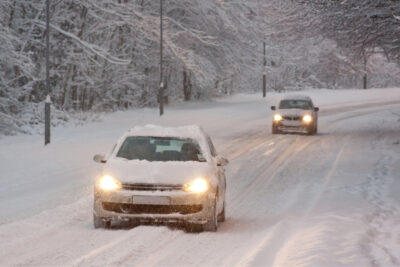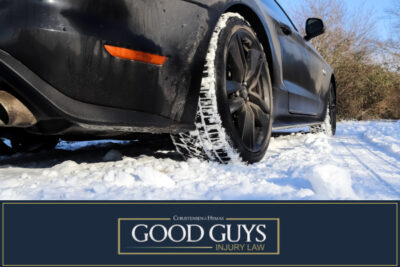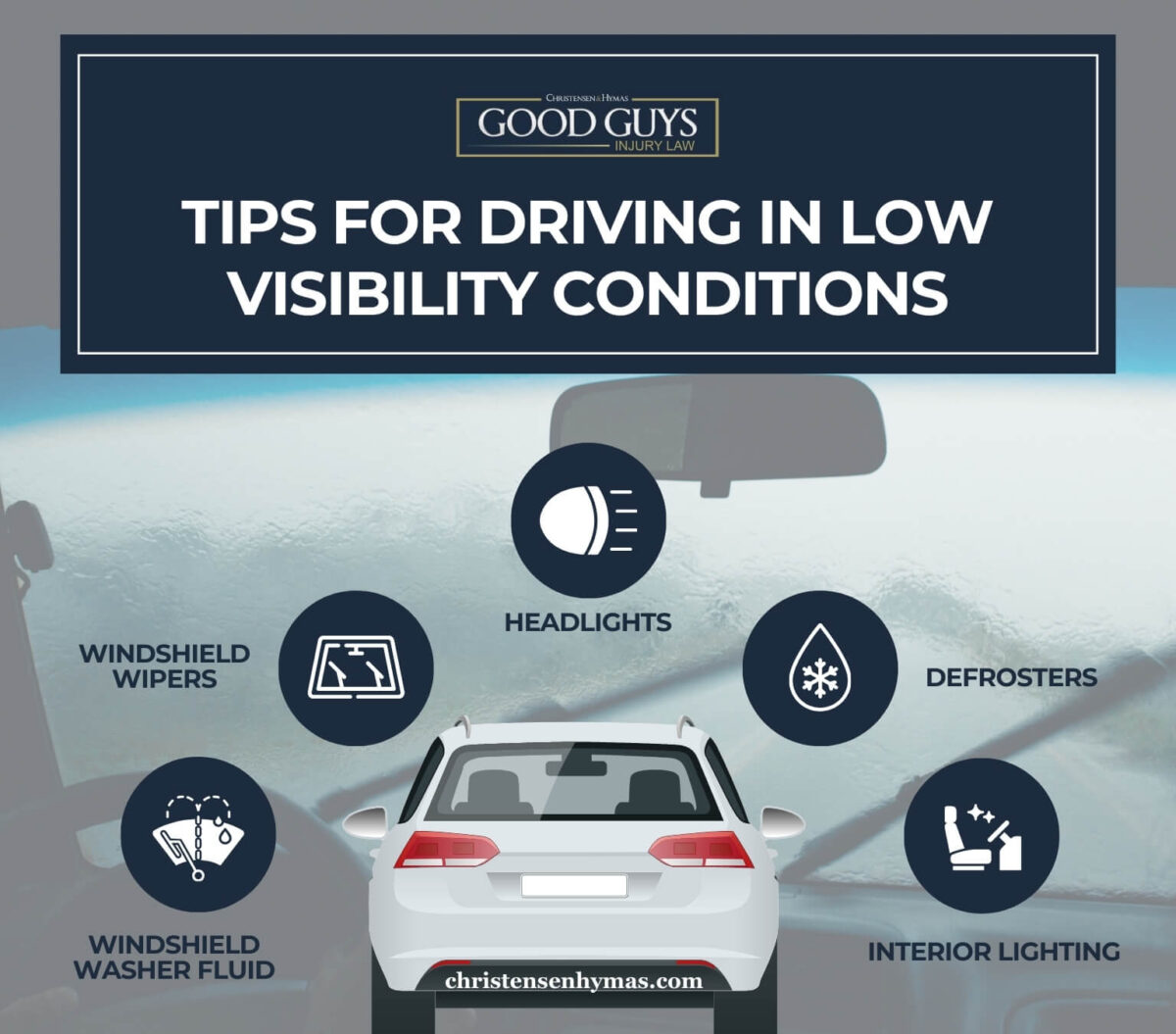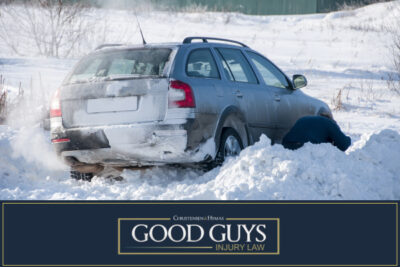
Winter weather challenges drivers in ways they do not often face during warmer months. Icy roads, snow-covered lanes, and sudden temperature drops can make winter driving conditions unpredictable. Cold weather also affects how your vehicle is handled, which means even short trips may require extra care. Knowing what to expect and following sensible winter driving tips can help you avoid serious problems. That is where Good Guys Injury Law can help you.
By preparing your vehicle and adjusting your driving habits, you can reduce your chances of an accident. Equip your car with the right tools, maintain it carefully, and recognize when it might not be safe to travel. Learn more about key winter driving advice below. Then, contact us to schedule a free case review.
Table of Contents
Preparing Your Vehicle for Winter Driving
Your car needs extra attention before snow and ice set in. Proper maintenance improves handling, visibility, and reliability when roads turn slippery. Start by ensuring your vehicle is ready for freezing temperatures, checking everything from windshield wipers to your gas tank to prevent unexpected breakdowns.
Inspecting Tires for Proper Tread Depth and Inflation
Worn tires struggle to grip the icy pavement, increasing your risk of sliding and losing control. Check tread depth to ensure your tires can push water and slush aside, improving contact with the road. Keep them inflated to the recommended pressure, and consider all-season or winter-specific tires for added traction. While focusing on winter tires, also top off your windshield wiper fluid so that clear vision remains possible, even in harsh conditions.
Balanced tires and proper inflation also improve your car’s overall stability. Regularly rotate them to promote even wear and extend their life. Pay attention to how your vehicle feels on the road; vibrations or pulling to one side might mean a tire or alignment issue. By catching these problems early, you reduce the chances of skids and car accidents.


Injured? Our Utah Car Accident attorney is here to help you.

Checking Brakes, Battery, and Antifreeze Levels
Your brakes must work well in slippery conditions, so have a professional inspect them regularly. Ensure your brake pedal feels firm, and test your antilock brakes to confirm they activate properly in sudden stops. A strong battery helps your engine start in cold weather, so check its charge and replace it if it struggles. Antifreeze keeps your engine and windshield washer fluid from freezing, so maintain proper levels to prevent costly damage.
Also, look over your exhaust pipe to ensure it remains clear of snow or ice, as blockages can lead to dangerous fumes inside the car. Confirm that all vehicle lights, including brake lights and signals, work correctly. Inspect your windshield washer fluid level and use a winter-grade formula designed to resist freezing. With every fluid and part in order, you can trust your car to respond when you need it most.
Keeping Emergency Supplies in Your Vehicle
- First aid kit. Keep bandages, antiseptic wipes, and pain relievers ready. These items help you treat minor injuries before professionals arrive.
- Ice scraper. Use it to clear the windshield for better visibility. A clean windshield improves your line of sight and prevents accidents.
- Snow brush. Remove snow from windows, mirrors, and lights. Clear views help you see other vehicles and reduce your risk of collisions.
- Dome light (Extra source of light). A working dome light helps you find items in the dark. If you have a portable lantern, that would be even better for emergencies.
- Floor mats. Placing floor mats under the tires can provide extra traction if you get stuck. They help the wheels grip the ground, making it easier to drive out of snowbanks.
- Brightly colored cloth. Tie it to your antenna or door handle if you break down. This signal can help rescuers find you in low visibility or remote areas.
- Windshield wipers (Extra set). Keep a spare set in case yours freeze or break. Reliable wipers ensure you can always maintain a clear view of the road.
These items can turn a challenging situation into a manageable one. Having them on hand means you face fewer surprises and respond to problems more effectively.
Driving Techniques for Winter Conditions

Adjusting how you operate your vehicle helps avoid crashes in icy or snowy environments. Simple changes like slowing down, giving yourself more space, and handling controls with care go a long way. Before we detail these steps, let’s break down specific methods. A few key techniques to follow include:
Slowing Down and Leaving Extra Following Distance
Driving slowly gives you time to react to sudden changes. Increase the gap between you and the car ahead, so you have room to brake if it stops suddenly. Always wear your seat belt, as it provides essential protection if you lose control. Patience and caution make a big difference in staying safe on slick roads.
Steering and Braking Gently to Avoid Skidding
Sudden, forceful movements often cause skids. Press the brake pedal smoothly, and steer gradually rather than jerking the wheel. Gentle input works with your car’s systems, helping maintain stability. Consider that your vehicle’s handling might differ in winter, so practice careful maneuvers.
Avoiding Sudden Acceleration on Icy Roads
Quick bursts of speed cause wheels to spin and lose traction. Press the gas pedal smoothly to maintain control and reduce wheel slip. If your car has cruise control, avoid using it on icy roads since it can cause unintended acceleration or braking. Careful, controlled acceleration keeps your ride steady and safe.
How to Handle Common Winter Driving Hazards
Even with caution, you may face tough challenges like sliding on ice or struggling in poor visibility. Knowing what to do helps you stay calm and make smart decisions. A few common scenarios include:
What to Do If You Start Skidding on Ice
- Stay calm. Take a deep breath and focus. Panicking makes it harder to react effectively.
- Do not slam the brakes. Sudden braking worsens the skid. Ease off the accelerator instead.
- Steer gently. Turn the wheel in the direction you want the front of the car to go. Smooth inputs help regain control.
- Use antilock brakes if equipped. Apply steady pressure and let the antilock brakes do the work. They prevent wheel lock-up and help maintain steering control.
- Look where you want to go. Your hands tend to follow your eyes. Focus on a safe spot, not the obstacle you want to avoid.
- Be patient. Recovery might take a moment. Do not overcorrect, as it can send you into another skid.
- Pull over if needed. If you feel shaken, stop in a safe area. Regain your composure before continuing.
Tips for Driving in Low Visibility Conditions

Driving when you cannot see far ahead makes reacting harder. You must slow down, stay alert, and use every tool at your disposal. A few key tips to follow include:
- Headlights. Turn on your headlights, even during daylight. Bright lights help others see you and improve your own view.
- Windshield wipers. Running windshield wipers clears moisture and helps you see better. Replace them if they streak or squeak.
- Defrosters. Use your defroster to clear the fog from inside the windshield. A clean view reduces hazards.
- Windshield washer fluid. Keep it topped off with a winter-grade fluid. Removing salt and grime maintains clarity.
- Interior lighting. Switch off your dome light when driving in low visibility. Bright interior lights create glare and make it harder to see outside.
Using these tools and techniques increases your chances of avoiding accidents. Sometimes, conditions get too rough, so do not hesitate to slow down or pull over.
Avoiding Black Ice and Other Hidden Hazards
Black ice forms a thin, transparent layer, making it easy to overlook. Look for shiny, dark patches on the road and assume they are slippery. Reduce speed before reaching them to maintain better control. When unsure, drive with extra caution and leave more room between you and other cars.
Staying Safe During Winter Emergencies

If you get stuck in snow or your car breaks down, remain calm and think clearly. Move your vehicle off the road if possible, turn on hazard lights, and call for help. Keep warm by using blankets or extra clothing, and run the engine occasionally to heat the interior. Check your exhaust pipe for blockages, as trapped fumes can enter the car and create a deadly hazard.
If you must wait, try to conserve fuel by turning the engine off when you can. If you are running the engine, crack a window slightly for fresh air. Stay visible by using a brightly colored cloth or setting up reflective markers. By being prepared and acting wisely, you can handle emergencies without panic.
How To Respond To a Winter Car Crash
If you are involved in a winter accident, knowing what to do can help you stay safe and protect your rights. Take a moment, breathe, and follow a few steps, including:
- Check for injuries. See if everyone is safe and check for injuries. Call for medical help if anyone seems hurt.
- Move to safety. If possible, move your car out of traffic and get to safety. Turn on hazard lights to warn others.
- Call the authorities. Report the accident to the local police or highway patrol. An official record helps with insurance claims.
- Exchange information. Share names, phone numbers, and insurance details. Take pictures of the scene and vehicle damage.
- Contact an attorney. A Utah car accident attorney can guide you through legal steps. They help protect your interests and ensure fair treatment.
Remember, staying calm and taking the right actions can make a big difference. The more prepared you are, the better you can handle a difficult situation.

If you have been injured in an auto accident, Our car accident attorney is here to help you.

Contact Our Utah Car Accident Attorney for a Free Case Consultation

At Good Guys Injury Law, our team understands how challenging it feels to deal with insurance claims, vehicle damage, and injuries. We always put our clients first, and we can do the same for you. Contact us today to schedule a free case review.
